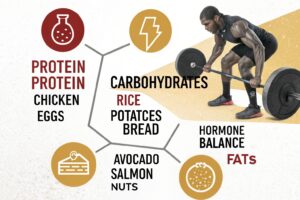Introduction
Achieving your fitness goals isn’t just about lifting heavier or running faster— it’s about feeding your body the right fuel at the right time. This comprehensive guide explores how to pair your workout plan with the ideal macro ratio, whether you’re aiming for fat loss, muscle gain, strength, or endurance. By the end, you’ll have a clear, actionable blueprint that turns nutrition and training into a seamless, results‑driven partnership.
Understanding Macro Ratios: The Science Behind Protein, Carbs, and Fats
Macronutrients—protein, carbohydrates, and fats—are the three pillars that provide energy, support recovery, and drive adaptation. Each plays a unique role: protein supplies the amino acids needed for muscle repair and growth, carbs fuel high‑intensity work and replenish glycogen stores, and fats regulate hormones and provide a long‑lasting energy source. Knowing how to balance these nutrients is the first step toward creating a macro‑based nutrition plan that aligns perfectly with your training stimulus.
The “ideal” macro ratio isn’t a one‑size‑fits‑all number; it shifts based on training volume, intensity, body composition goals, and even individual genetic factors. The key is to start with a scientifically grounded baseline, then fine‑tune using performance metrics, body composition tracking, and personal preference. Below we break down the most effective macro ratios for four common training objectives, complete with step‑by‑step calculations and practical meal‑planning tips.
Macro Ratio for Fat Loss: Maximizing Lean Tissue Preservation
Why a Higher Protein Ratio Is Critical
When you’re in a calorie deficit, the body can catabolize muscle tissue for energy. Elevating protein intake to 1.0–1.2 grams per pound of body weight (2.2–2.6 g/kg) mitigates this risk by supplying sufficient amino acids for muscle protein synthesis while still allowing the body to tap fat stores for the remaining energy needs.
Carbohydrate Timing to Protect Metabolism
Carbs become the most strategic macro for fat‑loss athletes. Aim for 0.8–1.2 g per pound (1.8–2.6 g/kg) on training days, focusing the majority around your workout (pre‑ and post‑exercise) to preserve glycogen, sustain performance, and accelerate recovery. On rest days, you can reduce carbs by 25–30 % and shift calories toward protein and fiber‑rich vegetables.
Healthy Fats to Support Hormones
Don’t skimp on fats; they’re essential for testosterone and cortisol regulation—both crucial during a deficit. Keep fat intake at about 20–25 % of total calories, prioritizing monounsaturated (olive oil, avocado) and polyunsaturated sources (fatty fish, nuts). This balance helps maintain metabolic rate while keeping you satiated.
Macro Ratio for Muscle Gain: Building Size Without Excess Fat/Nutrition + Training
Protein: The Cornerstone of Hypertrophy
Muscle growth thrives on a protein intake of 1.2–1.5 g per pound (2.6–3.3 g/kg). Consuming protein in 20–30 g portions every 3–4 hours maximizes the muscle protein synthesis window, ensuring a continuous supply of building blocks for new muscle fibers.
Carbohydrates for Energy and Anabolic Signaling
Carbs should constitute 45–55 % of your total calories when bulking. This translates to roughly 2.0–3.0 g per pound (4.4–6.6 g/kg). Prioritize complex carbs (brown rice, oats, sweet potatoes) for steady energy, and incorporate fast‑digesting carbs (fruit, dextrose) immediately post‑workout to spike insulin—a potent anabolic hormone that drives nutrients into muscle cells.
Fats for Hormonal Optimization
Aim for 20–30 % of total calories from fats, emphasizing omega‑3 fatty acids (salmon, flaxseed) to reduce inflammation and support joint health under heavier lifting loads. Maintaining adequate fat intake also helps sustain testosterone levels, further enhancing muscle‑building potential.
Macro Ratio for Strength Training: Power, Power, Power

Protein: Supporting Neural Adaptations
Strength athletes benefit from a protein intake similar to hypertrophy programs—1.0–1.2 g per pound (2.2–2.6 g/kg). However, timing leans more heavily toward the post‑workout window (within 30 minutes) to aid recovery from heavy loads and improve motor unit recruitment for subsequent sessions.
Carbohydrates: Fueling CNS and Maximal Lifts
Carbs become the primary energy source for the central nervous system (CNS) during heavy lifts. Allocate 2.5–3.5 g per pound (5.5–7.7 g/kg) on heavy training days, focusing on high‑glycemic carbs (white rice, potatoes) right before and after training to fully replenish glycogen and keep the CNS primed.
Fats: Sustaining Long‑Term Hormonal Health
Because strength cycles often span 8–12 weeks, keeping fats at about 25 % of total calories ensures stable hormone production. Include sources high in cholesterol precursors (egg yolks, dairy) and omega‑3s to support joint lubrication and reduce oxidative stress from heavy loading.
Macro Ratio for Endurance: Keeping the Engine Running
Protein: Preserving Lean Mass During High Volume
Endurance athletes risk losing lean tissue during prolonged training. A protein intake of 0.8–1.0 g per pound (1.8–2.2 g/kg) protects muscle fibers without excess calories that could hinder efficiency. Distribute protein evenly across meals to aid continual repair.
Carbohydrates: The Primary Fuel for Aerobic Work
Carbs dominate the macro profile for endurance—typically 55–65 % of total calories, or 2.5–3.5 g per pound (5.5–7.7 g/kg). Load glycogen stores before long sessions (carb‑loading 48 hours prior) and consume 30–60 g of carbs per hour during exercise (sports drinks, gels, fruit) to delay fatigue.
Fats: A Secondary Energy Source
In ultra‑endurance events, the body increasingly relies on fat oxidation. Keep fats at 15–20 % of total calories, focusing on medium‑chain triglycerides (MCT oil) and omega‑3s to enhance fat metabolism and reduce inflammation post‑effort.
How to Calculate Your Personal Macro Ratio: A Step‑by‑Step Guide
Step 1 – Determine Your Maintenance Calories
Use the Mifflin‑St Jeor equation (or a reliable calculator) to estimate basal metabolic rate (BMR). Multiply BMR by an activity factor that reflects your training frequency and intensity (1.55 for moderate, 1.75 for heavy). This gives you maintenance calories—the starting point for any macro adjustment.
Step 2 – Set Your Goal‑Specific Calorie Target
* Fat loss: Subtract 10–20 % from maintenance.
* Muscle gain: Add 10–15 % to maintenance.
* Strength: Add 5–10 % to maintenance.
* Endurance: Stay near maintenance or add a small 5 % surplus for recovery after high‑volume weeks.
Step 3 – Choose the Macro Percentages That Match Your Goal
Refer to the sections above for goal‑specific macro splits. Convert the percentages into grams using the calorie values (protein & carbs = 4 kcal/g, fats = 9 kcal/g). Example for a 2500 kcal maintenance plan aiming for muscle gain (30 % protein, 50 % carbs, 20 % fats):
-
- Protein: 0.30 × 2500 = 750 kcal → 750 ÷ 4 = 188 g
-
- Carbs: 0.50 × 2500 = 1250 kcal → 1250 ÷ 4 = 313 g
-
- Fats: 0.20 × 2500 = 500 kcal → 500 ÷ 9 ≈ 55 g
Step 4 – Adjust for Personal Variables
Track your weight, performance, and how you feel weekly. If you’re losing weight too quickly or feel constantly fatigued, add 5 % more carbs. If you’re gaining excess fat, trim carbs by 10 % while keeping protein stable. Use a simple spreadsheet or a macro‑tracking app to stay consistent.
Step 5 – Implement Meal Timing Strategies
* Pre‑Workout: 20–30 g carbs + 10 g protein 30–60 min before training.
* Intra‑Workout (endurance >90 min): 30–60 g fast carbs every hour.
* Post‑Workout: 0.3–0.4 g protein per lb + 1–1.2 g carbs per lb within 30 min.
* Rest Days: Shift calories toward protein and fiber, reduce carbs by 25 %.
Putting It All Together: Sample 7‑Day Meal Plan for a 180‑lb Hybrid Athlete
Day 1 – Upper‑Body Strength (30 % P / 45 % C / 25 % F)
Breakfast: 3 egg whites + 2 whole eggs, 1 cup oats, ½ banana, 1 tbsp almond butter (≈45 g P, 55 g C, 20 g F)
Post‑Workout Shake: 30 g whey, 1 cup pineapple, 1 tbsp honey, water (≈30 g P, 45 g C)
Lunch: 6 oz grilled chicken, 1.5 cup quinoa, mixed veggies, 1 tbsp olive oil (≈45 g P, 55 g C, 15 g F)
Dinner: 5 oz salmon, 1 cup sweet potato, asparagus, ½ avocado (≈35 g P, 40 g C, 20 g F)
Snack: Greek yogurt + berries (≈20 g P, 20 g C)
Day 2 – Long Run (20 % P / 60 % C / 20 % F)
Same macro distribution but increase carbs to 7 g per lb (≈1 cup rice, extra fruit, a banana during the run). Keep protein steady at 1 g per lb.
Day 3 – Rest Day (35 % P / 35 % C / 30 % F)
Focus on high‑quality fats: add extra nuts, seeds, and olive oil dressing. Reduce carbs to leafy greens, berries, and a small sweet potato.
Continue alternating strength, hypertrophy, and endurance days throughout the week. The key is consistency in macro targets, strategic timing, and weekly adjustments based on measurable outcomes.
Common Mistakes & How to Avoid Them
1. Ignoring Calorie Quality
Macro ratios are a framework, but the source of each macro matters for satiety, micronutrient intake, and recovery. Choose whole foods over processed equivalents—lean meats over deli slices, whole grains over refined flours, and nuts over chips.
2. Over‑Emphasizing One Macro
Relying heavily on protein while slashing carbs can compromise training intensity, especially for HIIT, strength, or endurance sessions. Keep carbs aligned with the energy demand of your workouts.
3. Neglecting Micronutrients and Hydration
Vitamins, minerals, and electrolytes support metabolic pathways for macro utilization. Incorporate a colorful array of vegetables, fruits, and adequate water (≈35 ml per kg body weight) to optimize performance.
4. Skipping Post‑Workout Nutrition
The 30‑minute anabolic window is a myth for some, but refueling soon after intense training accelerates glycogen restoration and protein synthesis. At minimum, consume a balanced snack within 2 hours of finishing.
5. Failing to Track and Adjust
Without consistent tracking (via apps, food diaries, or spreadsheets), you won’t know if you’re truly hitting your macro goals. Weekly weigh‑ins, body‑fat measurements, and training logs provide the data needed for fine‑tuning.
Final Takeaway: Your Blueprint for Success
Pairing your workout plan with the ideal macro ratio transforms nutrition from a vague concept into a precise performance tool. Start by identifying your primary goal—fat loss, muscle gain, strength, or endurance—then adopt the corresponding macro split outlined above. Calculate your personal calorie target, convert percentages into gram amounts, and apply strategic meal timing to fuel each training session. Track, assess, and adjust weekly, and remember that quality food choices, hydration, and micronutrient balance are the finishing touches that turn a good plan into a great one.
Stick to this systematic approach, and you’ll not only see measurable improvements in body composition and performance but also enjoy the confidence that comes from knowing exactly what and when to eat for optimal results.



